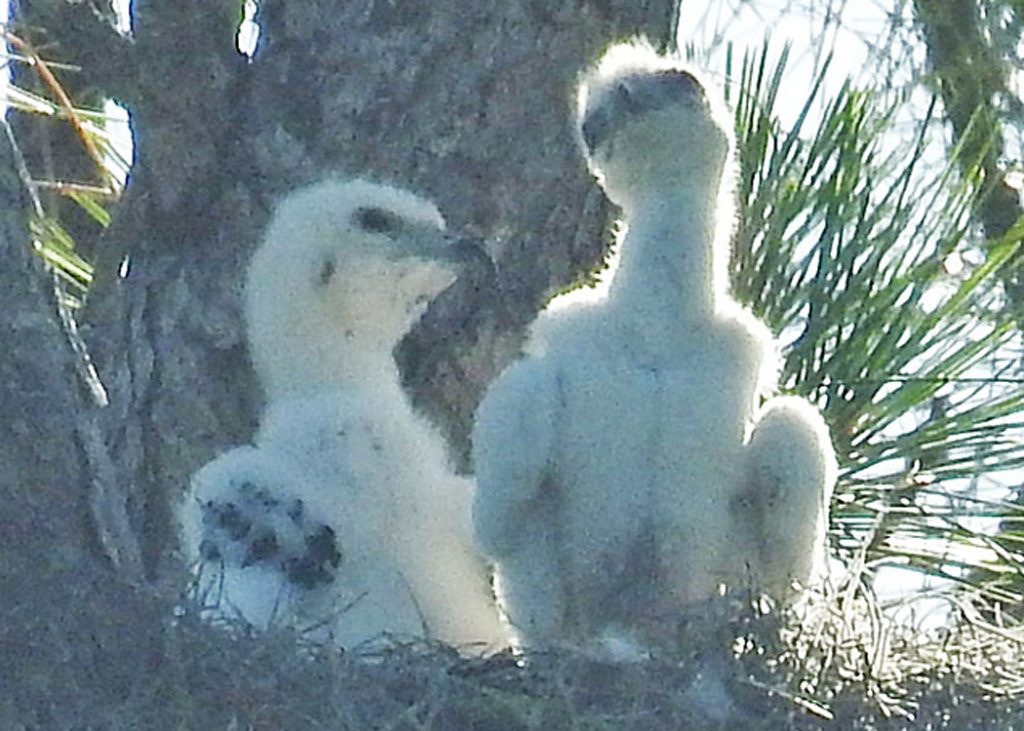By Nan Mattingly and Allison Vincent

If you’ve hung around any tall pine trees lately, there’s a chance – even if you didn’t notice – that you’ve been within view of one of southwest Florida’s most social flying raptors, the swallow-tailed kite (STKI). Returning from South America in mid-February every year like a romantic poem written especially for a birder just in time for Valentine’s Day, they almost immediately start circling the tall tree tops in search of their favorite nesting spot. We have a lot of unanswered questions regarding these world travelers, but there is plenty that we do know! This article will be a refresher course covering some of the top questions we hear from you about our black and white aerial artists at the CREW Trails.
STKIs Journey to Nest
When we begin to spot STKIs in Florida in mid-February, they must be tired from their long journey because they’ve just flown in from South America, a journey of up to 6,000 miles. Some of them make it as far as seven of the southernmost states in the U.S. but Florida is their preferred destination and we see them in the greatest numbers here. We’re fortunate at CREW because they have a few favorite nesting areas within the CREW Project and between February and August we have the privilege of seeing them circle and soar over the treetops.


On arrival they begin looking for suitable nesting sites. There are two essentials for nesting, which they do in loose communities. They need tall trees (preferably pines, occasionally cypress and other tall trees) in open woodland where they can hunt abundant prey by sight, and they prefer to be near a source of water – a swamp, river, marsh or a slough – because they also capture and consume creatures living next to or in the water. Most STKIs return to the same nesting sites every year, often fixing up an old nest. In the early part of their stay in Florida, you’ll see them circling high overhead inspecting the territory.
Relationships of Swallow-tailed Kites
STKIs are believed to be monogamous. They may continue a relationship from the previous year, or they may find a mate during migration. Once the colony has chosen a good nesting site, they establish small territories around and above the nests and they guard their territories (or neighborhoods) by flying in small circles above the nest tree. Intruders are repelled with dive bombs and scolding cries sometimes described as loud, squeaky whistles.
Both males and females bring nest materials to the site. They can build the nest quickly, in only one day, or more slowly, up to two weeks. They begin by making a platform of small, loosely woven sticks and then line it with soft materials such as lichen or Spanish moss, creating either a flat surface or a shallow cup. Most STKI nests are situated at least 60 feet above the ground.
Each pair of STKIs produces a clutch of one to three eggs which incubate for 27 to 33 days. After the eggs hatch, the parents feed them frequently. The male STKI catches and carries prey in his talons to the nest, where he passes it to the female. She then tears it up and feeds it to the young.










Photos by CREW Trust Volunteer Dick Brewer illustrating STKI development stages (starts at top left).
Breakfast, Lunch, and Dinner – Feeding on the Wing
To catch that prey, the male hunts during the day “on the wing”, while in flight, picking prey off trees, shrubs and vegetation along rivers or other water bodies. And what are they looking for? STKIs like large insects such as dragonflies, wasps, cicadas, beetles and grasshoppers which they eat while flying. During the breeding season, adults also hunt small vertebrates, including tree frogs, lizards, nesting birds, and snakes. Occasionally STKIs devour bats, fish or fruit.
We’re fortunate in southwest Florida to welcome these magnificent birds. You can identify them, at the right time of year (between February and August), first by noticing their long, forked tails and then by observing their graceful flight. They swoop and glide high overhead, catching insects in the air or descending to the treetops to find small creatures to eat. Unlike some other birds, they rarely flap their wings, and you should count yourself lucky if you see them on the ground. An individual STKI has a shrill “pee, pee, pee” call, but when they gather in flocks you’ll hear sweet, shrill cries or soft whistles. It’s a magical experience to find yourself looking up at a circling flock and hearing those whistles.

You may have noticed that the CREW logo features the swallow-tailed kite. We don’t like to choose favorites, but it’s hard to resist these charismatic birds which are recognized by many as the most beautiful bird of prey. Just ask Brenda Brooks, CREW Trust Executive Director until 3/31/22, when she will make her own version of a migration north.

